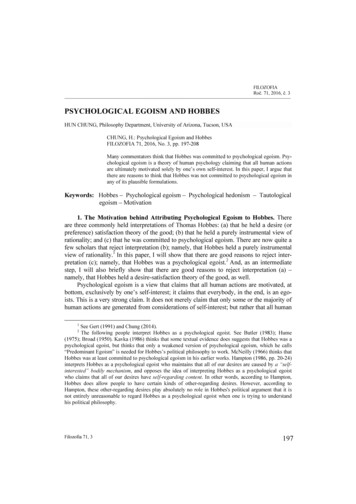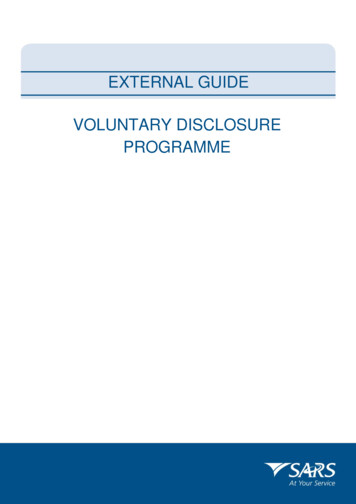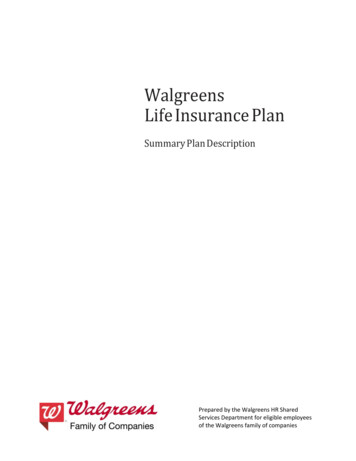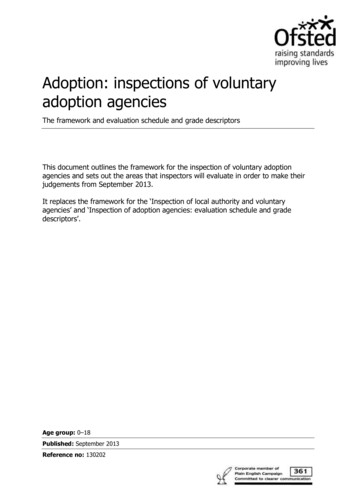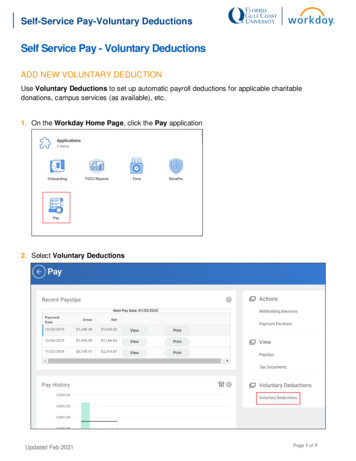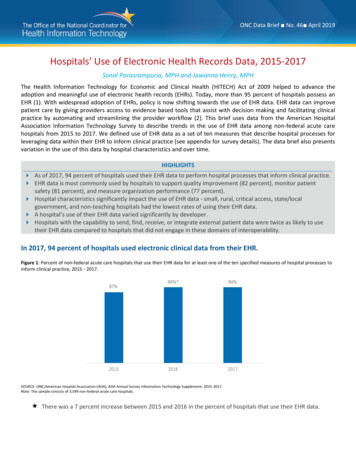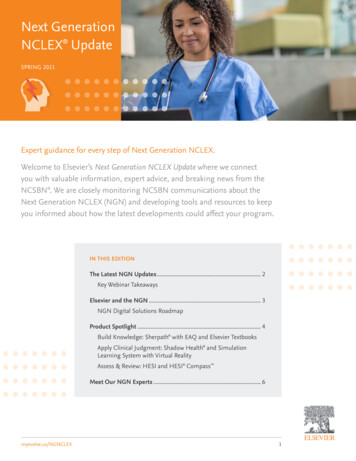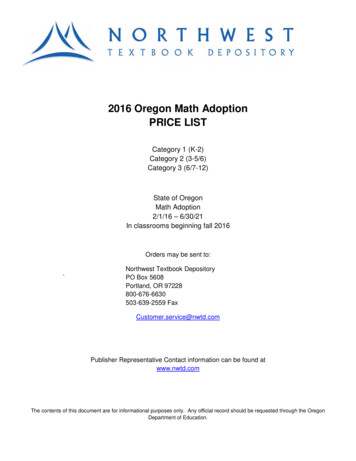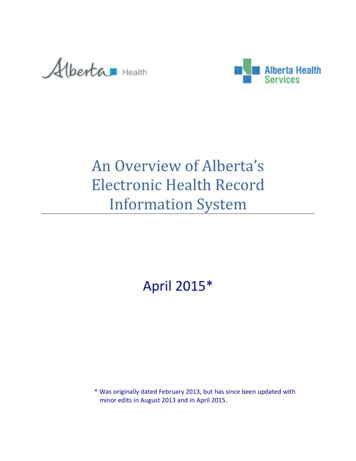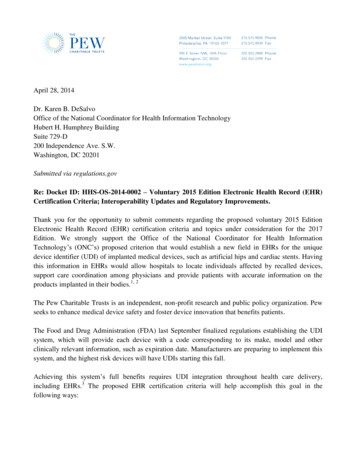
Transcription
April 28, 2014Dr. Karen B. DeSalvoOffice of the National Coordinator for Health Information TechnologyHubert H. Humphrey BuildingSuite 729-D200 Independence Ave. S.W.Washington, DC 20201Submitted via regulations.govRe: Docket ID: HHS-OS-2014-0002 – Voluntary 2015 Edition Electronic Health Record (EHR)Certification Criteria; Interoperability Updates and Regulatory Improvements.Thank you for the opportunity to submit comments regarding the proposed voluntary 2015 EditionElectronic Health Record (EHR) certification criteria and topics under consideration for the 2017Edition. We strongly support the Office of the National Coordinator for Health InformationTechnology’s (ONC’s) proposed criterion that would establish a new field in EHRs for the uniquedevice identifier (UDI) of implanted medical devices, such as artificial hips and cardiac stents. Havingthis information in EHRs would allow hospitals to locate individuals affected by recalled devices,support care coordination among physicians and provide patients with accurate information on theproducts implanted in their bodies.1, 2The Pew Charitable Trusts is an independent, non-profit research and public policy organization. Pewseeks to enhance medical device safety and foster device innovation that benefits patients.The Food and Drug Administration (FDA) last September finalized regulations establishing the UDIsystem, which will provide each device with a code corresponding to its make, model and otherclinically relevant information, such as expiration date. Manufacturers are preparing to implement thissystem, and the highest risk devices will have UDIs starting this fall.Achieving this system’s full benefits requires UDI integration throughout health care delivery,including EHRs.3 The proposed EHR certification criteria will help accomplish this goal in thefollowing ways:
Enhanced recall resolution: A list in EHRs of implanted devices will help providers identifypatients implanted with recalled products and deliver appropriate follow-up care.Improved adverse event reports: Inclusion of UDIs in EHRs will enable patients and providersto submit more precise adverse event reports that identify the make and model—and in somecases the lot number—of a potentially malfunctioning device.Better clinical decision support and care coordination: The inclusion of UDIs in EHRs willallow providers to make more informed decisions on patient care. This information is criticalwhen patients switch providers or see multiple physicians, all of whom may need informationon the specific device.Patient engagement: UDIs will provide a clear, accessible source of data on the devicesimplanted in patients’ bodies, enabling individuals to take more active roles in their care.Analyses on device performance: Increased data on device utilization can support hospitalanalyses on product performance in their patients. Hospitals could examine outcomesassociated with different devices, identify patient subpopulations that respond differently tocertain technologies, and better understand data on how physicians use certain products. Asefforts progress to extract and aggregate data from multiple EHRs, these analyses will becomemore sophisticated and will deliver increasingly relevant results.Mercy, a large multi-state health system, conducted a pilot project integrating cardiac stent deviceidentifiers into electronic data systems. Mercy experienced several benefits, including improved supplychain management and an ability to assess patient outcomes associated with different types of stents(drug-eluting compared to bare-metal).Specific comments on the proposed 2015 Edition EHR certification criteriaWe support the proposed 2015 Edition EHR certification criterion to enable the recording and viewingof the UDIs for patients’ implanted devices. We have three suggestions that would improve publichealth and minimize the burden on EHR vendors and health systems. ONC proposes to postpone adding UDI capture via automatic identification and data capture(AIDC) technologies until the 2017 Edition. However, delaying AIDC capabilities until 2017means that providers would need to enter the UDI into the EHRs manually. Given that the UDIcould be several dozen characters long, there is high probability that either: a) providers willchoose not to enter the UDI into the EHR, or b) there will be a high error rate associated withrecording the UDI (in addition to workflow inefficiencies). Neither of these two possibilities isdesirable.2
Therefore, ONC should consider requiring that certified EHR technologies have the capabilityto electronically record the UDI via at least one AIDC technology in the 2015 Edition. WhileFDA’s final UDI rule is technology-neutral, we suspect that standard bar coding capabilitieswill be among the most prevalent AIDC technologies used. Each EHR vendor should be able tochoose which AIDC technology to implement, but ensuring some automatic recordingcapability is critical to effectively using UDI. Generating a list of patients with a particular device is essential to many of the purposes ofrecording the UDI, including aiding hospitals with recalls and letting facilities perform analysesof device outcomes. The proposed rule, though, does not include this capability in the 2015Edition and delays it until the 2017 Edition. Given the importance of this feature, ONC shouldconsider requiring this capability in the 2015 Edition. ONC should also clarify that certifiedEHR technologies should be capable of generating these lists using either the device identifieror the device identifier and production identifier in tandem. Finally, the proposed rule does not specify whether the certification criteria would apply to allEHRs or only products used in certain care settings. Given that this proposed certificationcriteria focuses on implanted devices, ONC should consider whether this proposal should applyto all certified EHRs or only technologies used in hospital and ambulatory care environments.For certified EHR technologies intended for health care settings that do not perform implantprocedures, the ability to capture the UDI may be unnecessary at this time.Specific comments on the topics for consideration for the 2017 Edition EHR certification criteriaWhile the proposed 2015 Edition certification criteria will establish baseline functionality, we fullyexpect and support additional capabilities for the 2017 Edition. First, we support the proposal to develop dedicated data fields for device attributes and toautomatically populate them via an external database. The attributes associated with eachUDI—including the manufacturer, brand name, model number, Global Medical DeviceNomenclature (GMDN) name, single use indication and MRI safety status—provide criticalinformation on the product for use by both clinicians and patients. Automatic population ofthese fields from an external database, such as the FDA’s Global Unique Device IdentifierDatabase (GUDID), will ensure that this information is accurately incorporated and available toclinicians and patients without requiring them to manually retrieve and enter data. There areseveral reasons why this functionality is important.3
o A clinician treating a complex patient should be able to tell from a quick glance at theEHR the devices that are implanted in a patient. However, if EHRs do not link to anyexternal data sources, the clinician would just be presented with a list of UDIs with nocontextual information. The provider would then need to cross reference the GUDID oranother database and enter each UDI in order to figure out all of a patient’s medicaldevices.As one example of how this functionality is important, consider a physician who wouldlike to order an MRI on a patient with seven implanted devices. The clinician wouldhave to go to GUDID and enter the UDI seven different times to check each one forMRI compatibility if this information was not pulled into the EHR.As another example, a patient with multiple medical issues might show up at theemergency room of a medical center where he or she regularly seeks care. If this patienthad multiple implanted medical devices, the treating clinician would have to spendprecious time figuring out what each UDI represents. Does a particular UDI indicatethat the patient has an implanted stent, a cardiac defibrillator or a metal-on-metal hip?The clinician would have to enter each UDI into GUDID to be sure he or she had acomplete understanding of the patient’s medical history. This function should beautomated to ensure that errors are not made and to maximize the clinical benefits of theUDI.o Similarly, patients should be presented with basic information on their care, includingwhat device was implanted. If EHRs did not link to an external data source, patientscould be given the UDI at the time of discharge but it would be difficult to providemore information easily. It is unlikely that most patients would take the extra step ofgoing to GUDID to enter the UDI. In contrast, equipping patients with the name andmodel of the device as part of a discharge summary—which could be done if the EHRwere linked to an external database—would equip them to engage more actively in theircare, such as when they experience adverse events or hear about product recalls.o Additionally, automatically populating these fields from an external data set will helpensure the accuracy of the UDI that is entered into an EHR, especially if the UDI fieldis populated manually. For example, if the physician implants a hip—but the UDI keyedinto the patients’ EHR displays information on a cardiac stent—the provider will knowthat the UDI was incorrectly entered into the patients’ record and ensure that the correctinformation is entered.4
o There are hospital-level benefits as well. Downloading these fields into the EHR willallow hospitals to search for all patients with devices in a specific class in order tonotify patients affected by class-wide issues. For example, if a hospital wanted tocontact all patients who had received a metal-on-metal hip at that facility, it wouldpotentially need to perform searches for many UDIs in order to find all affectedpatients. However, if the GMDN code—which classifies devices—were available in theEHR, the hospital could search for all patients who had received a device with thatGMDN code. Utilizing the GMDN would prevent omissions from failing to search forall the relevant UDIs or incorrectly classifying certain devices within a particularcategory, such as mis-categorizing a ceramic-on-ceramic hip as a metal-on-metal hip.This functionality is not a new one; EHRs currently pull data from other third party databasesfor other purposes. For example, EHRs contain information on pharmaceuticals—typicallyloaded from third-party databases—on dosing, indications and drug-drug interactions.4 Parityfor devices for automatic population of some data elements—such as the make and model—would prevent errors, increase time for direct patient care and ensure doctors are adequatelyinformed on the devices used by their patients. Second, as mentioned previously, integrating automatic UDI capture—such as through barcoding technologies—is essential to ensure the accurate recoding of UDIs, facilitate workflowoptimization and support interoperability among the electronic systems within a hospital. Wesupport enabling at least one method of AIDC in the 2015 Edition and additional AIDCcapabilities in the 2017 Edition. Third, we strongly support the proposed capabilities to ensure that UDIs can be transmitted toreporting systems and registries. These capabilities will enable more accurate adverse eventreports, facilitate efficient population of registries, and support other systems that associatepatients with specific devices. ONC should consider adding two more capabilities for certified EHR technologies.o The 2017 Edition should require the capability to automatically alert clinicians in theevent of known device risks with MRI compatibility. Upon ordering an MRI, theprovider should receive an automated alert if the patient has an MRI-incompatibledevice. This is another reason why automatic integration of the EHR with the GUDIDor another external database to populate device attributes is essential.5
o Additionally, ONC should also consider an additional capability to proactively providepatients with information on their device beyond the UDI, make and model. Patientswould benefit from accessing educational information, operating instructions andproduct labels. This could occur by ensuring that EHRs automatically transmit UDI datainto patient portals, which could then provide this additional information. This approachis consistent with previous EHR certification criteria that required capabilities foridentifying other patient-specific education resources.Additional federal policies neededThe proposed 2015 and 2017 Edition EHR certification criteria to capture UDIs will greatly supportefficient health information exchange to improve patient safety and enhance the quality of care. Toensure that these proposed capabilities are fully utilized, the Meaningful Use program should alsoinclude a new objective to encourage hospitals and providers to document UDIs when they implant amedical device in a patient. Therefore, we support the recommendation by the Health InformationTechnology Policy Committee to create a new Meaningful Use objective to provide incentives forhospitals to capture the UDIs of implanted devices.Furthermore, UDI capture in EHRs alone is essential, but insufficient to achieve the full benefits of thisnew UDI system. UDI incorporation in materials management, charge capture, billing and claimssystems will support additional benefits, including supply chain efficiencies and the availability ofmore data on devices to assess quality and reduce costs. Given that UDI integration throughout healthcare delivery is still in its infancy, ONC should—working with FDA, providers, device manufacturers,distributors, insurance companies and other health care stakeholders—develop a plan to promote theadoption and nationwide exchange of UDI data to improve patient care. In particular, the Centers forMedicare & Medicaid Services, which has access to large amounts of data, should participate in thedevelopment of this plan, especially regarding UDI integration into claims. These proposed EHRcertification criteria are a positive, critical next step in that plan, but insufficient on their own.Thank you for your consideration of our comments. Should you have any questions or if we can be ofassistance, please contact Josh Rising, director of medical devices at The Pew Charitable Trusts, at202-540-6761 or jrising@pewtrusts.org.Sincerely,6
Josh Rising, MDDirector, Medical DevicesThe Pew Charitable Trusts1Gross TP, Crowley J. Unique Device Identification in the Service of Public Health. N Engl J Med. 2012; 367:1583-1585.U.S. Food and Drug Administration. Strengthening our National System for Medical Device Postmarket CDRH/UCM301924.pdf.Accessed February 6, 20143Wilson NA, Drozda J. Value of Unique Device Identification in the Digital Health Infrastructure. JAMA.2013;309(20):2107-8.4Fotsch EJ. Electronic Health Records: The New Vehicle for Drug Labeling, Safety, and Efficacy. ClinPharmacol Ther. 2012;91:917–919.27
Specific comments on the proposed 2015 Edition EHR certification criteria We support the proposed 2015 Edition EHR certification criterion to enable the recording and viewing of the UDIs for patients' implanted devices. We have three suggestions that would improve public health and minimize the burden on EHR vendors and health systems.
